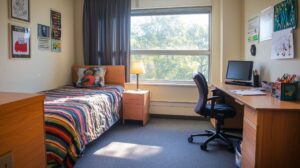
Choosing the right college housing is one of the most impactful decisions students make, directly influencing their academic performance, social connections, and personal comfort. On-campus dorms offer convenience and built-in communities, while off-campus apartments provide independence and real-world experience. Thoughtful selection can ensure living arrangements enhance rather than hinder the college experience.
This comprehensive checklist covers essential aspects every student should evaluate before making a decision.
Location and Accessibility
Proximity to campus is crucial because it can directly impact a student’s daily routine and academic efficiency. Living near classrooms, libraries, and dining facilities can minimize travel time, allowing more hours for studying, extracurriculars, and rest. Walkable routes or reliable public transit options can also reduce dependency on cars, cutting fuel and parking expenses. Bike-friendly paths offer an eco-friendly and cost-effective alternative.
For off-campus housing, testing the commute during rush hour is essential as delays can disrupt schedules and increase stress. A convenient location can also enhance productivity and ensure students can easily access campus resources, social events, and emergency services when needed.
However, for students attending Brigham Young University-Idaho (BYUI) or similar institutions, exploring BYUI student housing options can provide a balance between convenience and comfort. Private rooms can offer added privacy and focus—an advantage for those who value a quiet study environment.
Budget and Affordability
College housing costs vary by location, type (dorms, apartments, shared housing), and included amenities. Before signing a lease, students should compare on/off-campus prices, budget for utilities (internet, electricity), factor in deposits and fees, assess transportation costs, and explore financial aid or roommate options to reduce expenses. Careful planning can prevent overspending and ensure affordable, sustainable living arrangements throughout the academic term.
Additionally, students should research seasonal pricing fluctuations—some off-campus rentals offer lower rates during summer months. Investigating included amenities (like gyms or study rooms) can reveal hidden value. Those eligible for work-study programs might also explore university employment that includes housing discounts, further optimizing their housing budget while maintaining quality living standards.
By creating a realistic monthly budget, students can prevent overspending on housing. Shared apartments split rent/utilities between roommates, significantly lowering costs while maintaining livability. Students should also track all expenses—rent, groceries, transportation—to balance affordability with comfort. Budget-friendly housing can help preserve funds for academic needs and emergencies.
Roommate Compatibility
Living with roommates can make housing more affordable, but clear communication is essential to avoid conflicts. Students should discuss schedules (sleep/study times), cleaning duties, guest policies, and shared expenses upfront. Establishing boundaries early also ensures a harmonious living environment. Written agreements can help prevent misunderstandings, making shared housing both budget-friendly and socially manageable throughout the academic year.
To further streamline cohabitation, roommates should designate shared storage spaces and establish protocols for borrowing personal items. Scheduling monthly check-ins allows for addressing concerns before they escalate. These proactive measures can transform financial practicality into positive communal living, balancing independence with cooperative responsibility in shared academic housing.
Furthermore, roommate agreements can establish clear guidelines for shared living spaces, preventing conflicts before they arise. These written or verbal pacts should cover quiet hours, chore divisions, guest rules, and shared expenses. By addressing expectations upfront, students can foster mutual respect and accountability, creating a more harmonious cohabitation experience for all residents involved.
Safety and Security
A secure living space is essential for student well-being. Critical safety measures include verifying functional door/window locks, adequate exterior lighting, and secure entry systems. Students should also check smoke detectors, fire extinguishers, and emergency exits. Researching neighborhood crime rates and choosing housing with security features like cameras or on-site staff can provide additional protection for peace of mind. Students should also inquire about the landlord’s emergency maintenance response times and keep a list of campus security contacts.
Furthermore, familiarizing themselves with evacuation routes and establishing a personal safety protocol (like a buddy system for night returns) adds crucial layers of protection to their daily campus living experience.
Lastly, proactively investigating an area’s safety statistics and former residents’ experiences can reveal critical insights about potential risks. Online crime maps, campus security reports, and tenant review platforms can also help assess security concerns before signing a lease. This due diligence can prevent unsafe housing choices that could jeopardize wellbeing or property.
Amenities and Furnishings

When evaluating college housing, students should prioritize key amenities that impact daily life. Some essential features include reliable high-speed internet for coursework, in-unit or on-site laundry facilities, and adequate furniture like beds, desks, and storage. Additional considerations include kitchen appliances, heating/cooling systems, and study spaces to ensure both comfort and academic functionality in the living environment.
Students should also verify cell phone reception quality and proximity to essential services like grocery stores and pharmacies. Checking for noise insulation between units and availability of bike storage can significantly impact daily convenience. These often-overlooked factors can contribute greatly to long-term satisfaction with their chosen housing arrangement.
Moreover, furnished apartments can provide immediate move-in readiness with essential furniture like beds, desks, and seating included. This eliminates the cost and effort of transporting bulky items, ideal for students with limited resources or temporary stays. Convenience allows them to focus on academics rather than logistics.
Lease Terms and Flexibility
Before signing a lease, students must thoroughly review all terms to avoid costly surprises. Some key steps include verifying lease duration (semester vs. annual), understanding utility responsibilities, checking subletting policies, and noting penalties for late payments or early termination. Inspecting the property for damage and clarifying maintenance procedures are equally crucial to ensure a fair, stress-free rental experience. Students should also confirm pet policies if applicable and parking availability details.
Having a parent or legal advisor review complex lease clauses can provide extra protection. These precautions can help avoid unexpected restrictions or fees, ensuring the housing agreement fully aligns with their academic needs and lifestyle preferences.
Additionally, short-term leases (3-6 months) can accommodate academic schedules or study abroad plans, avoiding year-long commitments. However, landlords typically charge premium rates for this flexibility. Students should also weigh the convenience against the increased monthly cost, as these agreements can be 10-30% more expensive than standard annual leases.
Social and Community Environment
This type of housing can significantly shape a student’s social experience. On-campus dorms can facilitate connections through structured events, shared common spaces, and proximity to peers, ideal for those seeking built-in community. Off-campus living can also provide greater autonomy but requires more effort to build relationships through classes or student organizations. Students should assess whether they prioritize spontaneous interactions (dorms) or private independence (apartments), as this choice impacts their daily social dynamics and support systems.
The transition between housing types also affects adjustment periods—dorms offer instant socialization while apartments demand intentional networking. Students balancing academics with extracurriculars might prefer dorms’ built-in social infrastructure, whereas self-directed learners often thrive in apartments’ focused environments. This decision can ultimately shape their college experience’s social rhythm and personal growth opportunities.
Lastly, residence halls can promote constant social interaction through shared spaces and organized activities, ideal for extroverts. Conversely, private rooms offer introverts controlled social exposure and quiet retreats for recharging. This distinction can help students align their housing with personality-based needs for optimal academic and emotional well-being.
Health and Wellness Considerations
A well-maintained living environment can directly support student success by reducing stress and illness. Some key factors include proper ventilation to prevent mold, access to natural light, noise control for focused study, and ergonomic furniture. Students should also verify cleaning schedules, pest control measures, and proximity to campus health services to maintain both physical and mental wellbeing throughout their academic journey.
Additionally, students should assess building maintenance responsiveness and trash disposal systems. Green spaces nearby and air quality controls can further enhance wellness. These often-overlooked environmental factors can significantly impact sleep quality, immunity, and concentration, making them just as vital as academic resources for sustaining peak performance during demanding semesters.
Final Walkthrough and Move-In Checklist
Before moving in, students should conduct a thorough inspection to protect their interests. Essential steps include photographing the unit’s condition to document pre-existing damage to avoid liability, testing all appliances and utilities, verifying smoke detector functionality, confirming cleaning was completed, and reviewing move-in checklists with the landlord. These precautions prevent disputes over security deposits and ensure a smooth transition into their new living space.
Students should also request copies of all appliance manuals and maintenance records, while noting utility meter readings on move-in day. Scheduling this inspection during daylight hours ensures better visibility of issues. These often-missed steps provide crucial documentation and operational knowledge that safeguard both finances and daily functionality throughout the lease term.
Furthermore, documenting the apartment’s condition with timestamped photos upon move-in can create crucial evidence for security deposit disputes. Students should also capture all walls, floors, appliances, and fixtures to record existing damage. This visual proof can protect against unfair charges when moving out, ensuring landlords can’t blame tenants for pre-existing issues.
Final Thoughts
Selecting the right college housing requires thorough research and planning. By keeping this college housing checklist, students can find a living arrangement that enhances their academic journey. Whether opting for student housing or an off-campus apartment, this checklist ensures no critical detail is overlooked.






